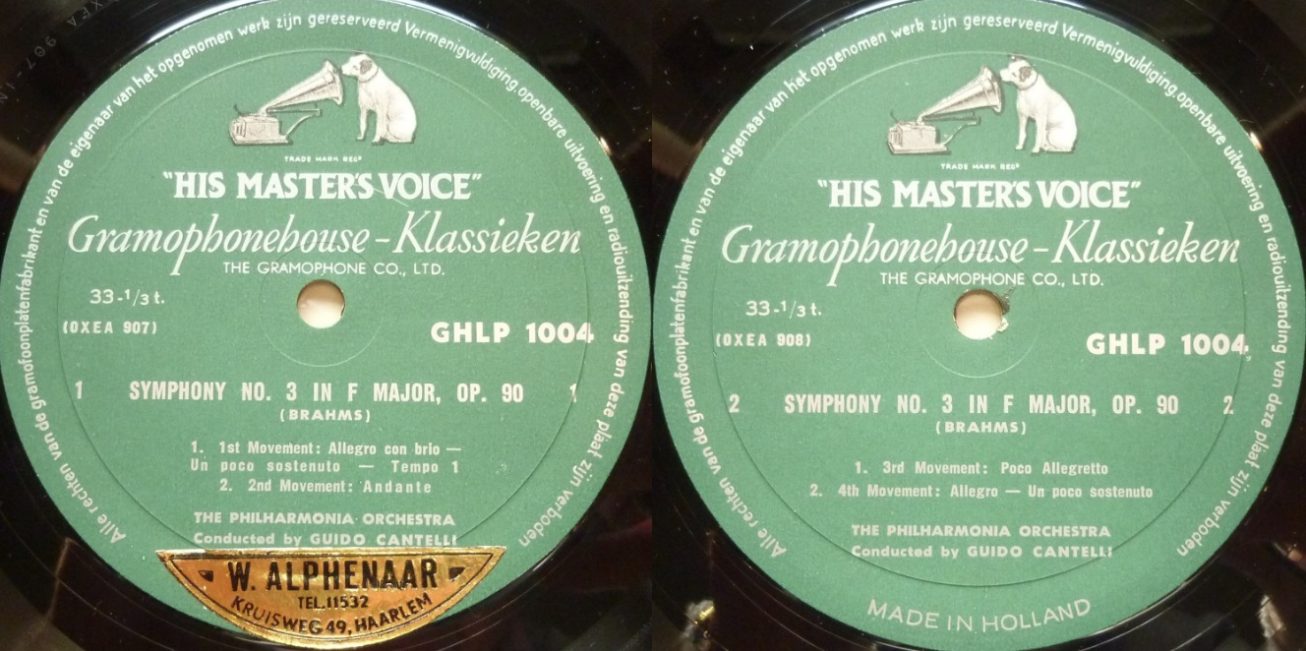Étiquette : Brahms

Kathleen Ferrier
Brahms Alt-Rhapsodie Op.53: Chœur d’Hommes et Orchestre de la Radio Danoise (Symfoniorkestret /Statsradiofoniens Mandskor: Svend S. Schultz)
dir: Fritz Busch
2 Lieder: Von ewiger Liebe Op43-I – Wir wandelten Op96-II Phyllis Spurr, piano
Radio Studio n°1 – 6 octobre 1949 Source: 33t/LP Danacord DACO 114
___________
Mahler Kindertotenlieder: WPO Bruno Walter
Kingsway Hall 4 octobre 1949
Prod: Walter Legge/Leonard Smith – Eng: Douglas Larter
Source 33t/LP: Angel Japan EAC-57048
En l’espace de deux jours, Kathleen Ferrier nous a offert deux enregistrements majeurs.
Tout d’abord à Londres où le Philharmonique de Vienne (WPO) était présent du 28 septembre au 6 octobre 1949 au cours d’une tournée dirigée par Furtwängler qui rejoindra ensuite Paris, Genève et Zürich.
Ferrier et Walter, de retour d’Edimbourg, ont donné à Londres les 1 et 2 octobre deux concerts Mahler avec les Kindertotenlieder et la Deuxième Symphonie (BBC SO and Choral Society).
Le 4, Furtwängler a dirigé avec le WPO un concert Brahms avec Menuhin, et une séance d’enregistrement a pu être programmée l’après-midi (14h30-17h30) au Kingsway Hall pour capter les Kindertotenlieder avec Bruno Walter.
Walter dirigea un concert londonien avec le WPO le 6. Mais, ce fut sans Ferrier qui chantait ce jour-là la ‘Alt-Rhapsodie’ avec Fritz Busch à Copenhague. De toutes façons, avec le WPO à Londres, elle n’aurait pas pu chanter l’œuvre de Brahms : Furtwängler avait déjà mis la ‘Alt-Rhapsodie’ au programme de son concert du 28 septembre (avec Mary Jarred).
Le programme dirigé par Fritz Busch avec son Orchestre de la Radio Danoise comprenait la Symphonie n°7 Op.70 de Dvorak (à l’époque dénommée ‘n°2’ comme lors de sa publication), et en deuxième partie, un ou plusieurs airs de l’ ‘Orphée’ de Gluck, puis la Rhapsodie Op.53 de Brahms et enfin les Métamorphoses d’Hindemith:
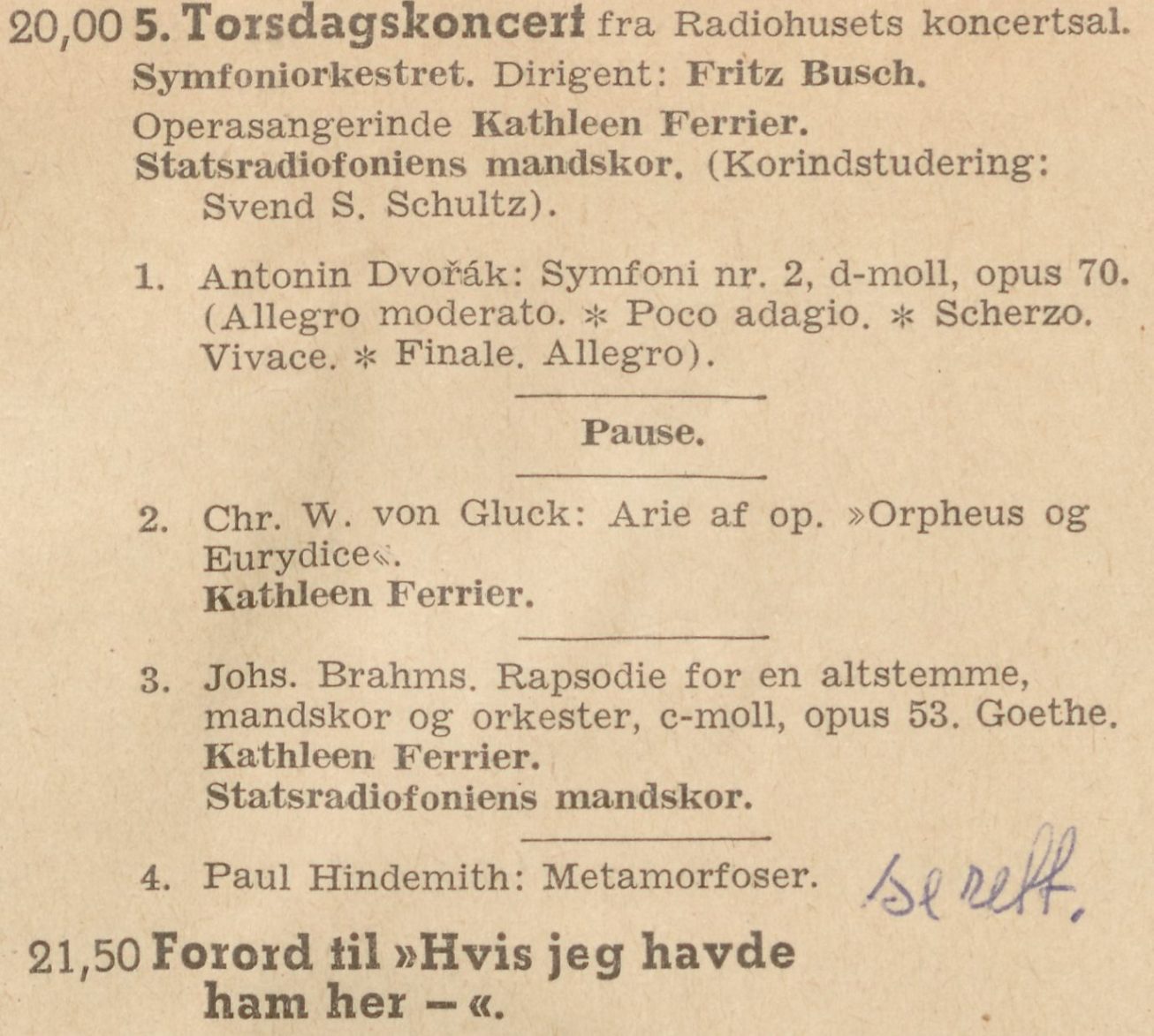
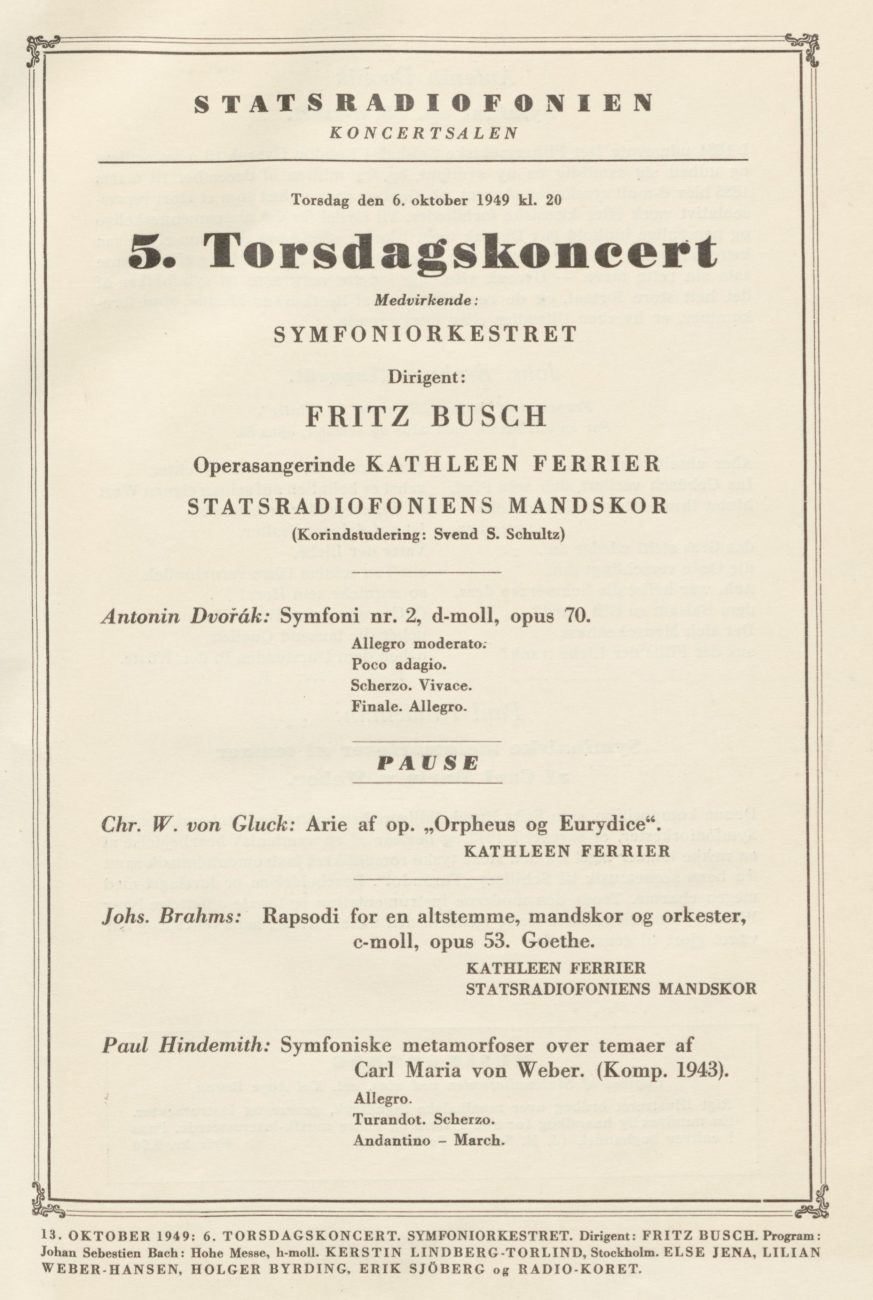
On voit que les deux Lieder de Brahms, probablement joués en bis, dans lesquels Ferrier est accompagnée par sa pianiste venue spécialement pour sa tournée en Scandinavie, ne figurent pas dans ce programme officiel. On les trouve par contre avec Gluck dans une feuille annexe de la Radio:

L’enregistrement de la Rhapsodie Op.53 a été complété par des sources provenant d’enregistrements privés de l’émission de la Radio Danoise pour compenser les parties dégradées de l’archive officielle. Les deux Lieder sont incomplets. Il manque les six premiers vers du premier Lied, et le début de l’introduction pianistique de l’autre.
Kathleen Ferrier et Fritz Busch se sont retrouvés avec l’Orchestre de la Radio Danoise au Festival d’Edimbourg, le 28 août 1950, avec le Royal Choral Union d’Edimbourg pour cette Rhapsodie Op.53.
Fritz Busch avait prévu de faire son grand retour à Berlin en mars 1952. A cette occasion, il avait invité Kathleen Ferrier à ses concerts qui devaient avoir lieu avec les 16 et 17 mars avec l’Orchestre de la RIAS. Sa disparition en septembre 1951 a réduit ce projet à néant.
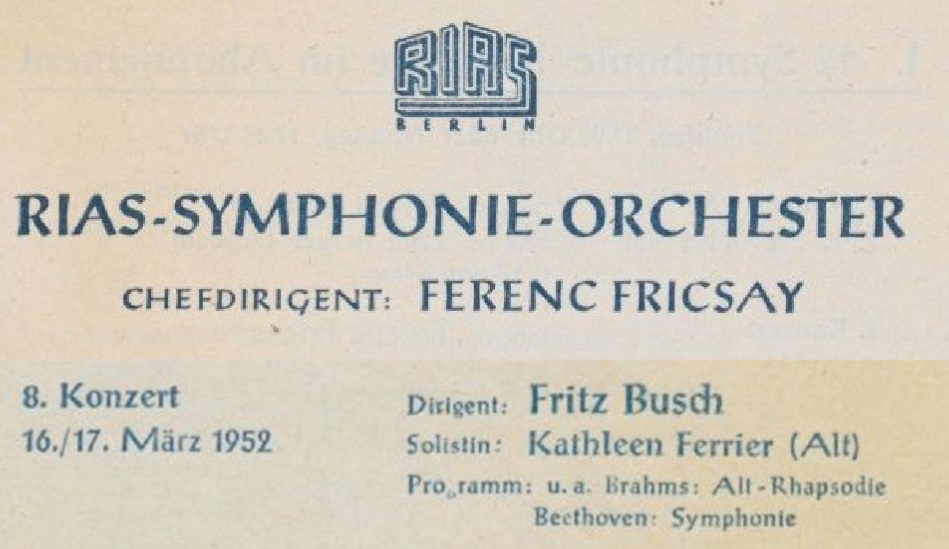
____________

____________
Within two days, Kathleen Ferrier offered us two major recordings.
To start with, in London where the Vienna Philharmonic (WPO) was present between 28 September to 6 October during a tour conducted by Furtwängler which later joined Paris, Geneva and Zürich.
Ferrier and Walter, back from d’Edinburgh, gave on October 1 and 2 two Mahler concerts in London with the Kindertotenlieder and the Second Symphony (BBC SO and Choral Society).
On the 4th, Furtwängler conducted a Brahms concert with Menuhin and the WPO, and an afternoon recording session (2.30pm – 5.30pm) has been set at Kingsway Hall to record the Kindertotenlieder with Bruno Walter.
Walter took the opportunity of being in London to conduct one concert with the WPO on the 6th. But it was without Ferrier who, on that very day, sang the ‘Alt-Rhapsodie’ with Fritz Busch in Copenhagen. Anyway, with the WPO in London, she might not have sung the work by Brahms : Furtwängler already put the ‘Alt-Rhapsodie’ at the program of his concert on 28 September (with Mary Jarred).
The programme conducted by Fritz Busch and his Orchestra of the Danish Radio was comprised of Dvorak’s Symphony n°7 Op.70 (then named ‘n°2’ as when it was published), and for the second part, Arias from Gluck’s Orpheus, then the Rhapsodie Op.53 by Brahms and to end with, Hindemith’s Metamorphosen:

We see that the two Brahms’Lieder, probably performed as encores, in which Ferrier is accompanied by her pianist who came especially for her Scandinavian tour, are not mentioned in this official programme. They are however found with the Gluck item in an extra Radio programme sheet:

The recording of the Rhapsody Op.53 was completed by private sources coming from the broadcast of the Danish Radio Danoise to compensate for the unusable parts of the official archive. Both Lieder are incomplete. The six first verses of the first Lied are missing, as well as the beginning of the piano introduction of the second.
Kathleen Ferrier and Fritz Busch met again with the Danish Radio Orchestra at the Edinburgh Festival on 28 August 1950, with the Edinburgh Royal Choral Union for this Rhapsody Op.53.
Fritz Busch scheduled his postwar return to Berlin for March 1952. He seized the opportunity for inviting Kathleen Ferrier to his concerts that were to take place on 16 and 17 March with the RIAS Orchestra. His death in September 1951 ruined this project.

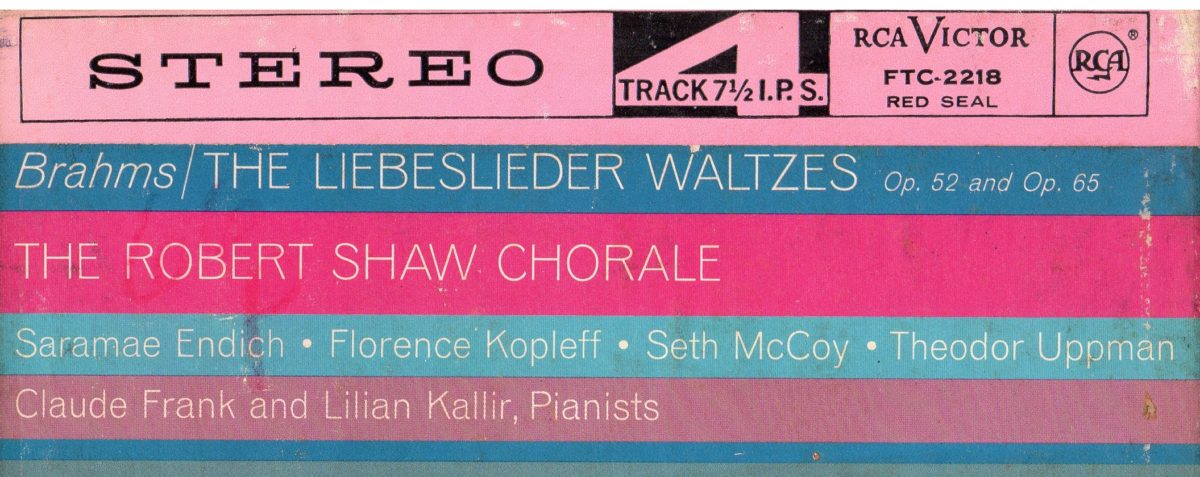
The Robert Shaw Chorale
Saramae Endich, soprano; Florence Kopleff, contralto;
Seth McCoy, tenor; Theodor Uppman, baritone
Claude Frank & Lilian Kallir, pianos
Enr/Rec: New-York 1965 – Source: Bande/Tape: 4 pistes 19 cm/s / 4-track 7.5 ips FTC-2218
Robert Shaw (1916-1999) est avant tout connu pour sa collaboration avec Arturo Toscanini entre 1948, année où il fonde la Robert Shaw Chorale, et 1954. Lors de la dernière saison de Toscanini avec le NBC SO, il était prévu que Toscanini dirige avec la participation de la Robert Shaw Chorale ‘Un Ballo in Maschera’ de Verdi, ainsi que le Psalmus Hungaricus de Kodaly. Pour le dernier concert, le 4 avril 1954, le choix s’était porté sur le Deutsches Requiem de Brahms (chanté cette fois en allemand), mais ce projet a été abandonné et Walter Legge, dans une lettre du 5 janvier 1954 à Walter Toscanini, a exprimé sa profonde déception que le programme de ce concert ait été annulé et remplacé par un concert Wagner, et ce d’autant plus qu’il était prévu que son épouse Elizabeth Schwarzkopf chantât la partie de soprano du Requiem de Brahms. Quant à Robert Shaw, sa dernière collaboration avec Toscanini a été pour le magnifique concert du 14 mars 1954 (Boïto Mefistofele Prologue et Verdi Te Deum).

Radio Age – October 1953
_________________
Pour cet enregistrement, réalisé peu de temps avant qu’il devienne le Directeur Musical de l’Orchestre Symphonique d’Atlanta, Robert Shaw a choisi d’utiliser un chœur de chambre, en ayant toutefois recours à un quatuor de solistes vocaux pour certains des Lieder, essentiellement dans l’Op.65. Les critiques de l’ époque ont considéré que cela nuisait à l’intimité de l’œuvre qui relève de la ‘Hausmusik’. Toutefois, les enregistrements sont souvent réalisés sans les reprises et avec des chanteurs connus, ce qui donne un caractère de quatuor vocal dont les membres sont nettement individualisés. En tous cas, l’interprétation de Shaw est pleine de finesse et même, on se croirait à Vienne !

Hi-Fi Stereo Review – November 1966
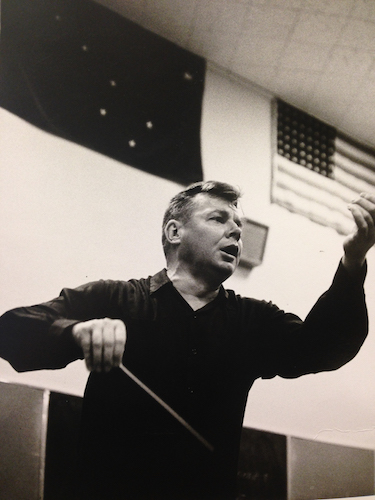
Robert Shaw (1916-1999) is above all known for his performances with Arturo Toscanini between 1948, the year he grounded the Robert Shaw Chorale, and 1954. for Toscanini’s last season with the NBC SO, it was scheduled that Toscanini would conduct with the Robert Shaw Chorale Verdi’s ‘Un Ballo in Maschera’, as well as the Psalmus Hungaricus by Kodaly. For the last concert, on Avril 4, 1954, the choice was Brahms’ Deutsches Requiem (this time sung in German), but the project was abandoned and Walter Legge, in a letter he sent to Walter Toscanini on January 5, 1954, expressed his deep disappointment that the programme of this concert had been cancelled and replaced by a Wagner program, all the more so since his wife Elizabeth Schwarzkopf was to sing the soprano part in the Brahms’ Requiem. As to Robert Shaw, his last performance with Toscanini was for the wonderful concert of March, 14 1954 (Boïto Mefistofele Prologue and Verdi Te Deum).
_________________
For this recording, made shortly before he became the Music Director of the Atlanta Symphony Orchestra, Robert Shaw chose a chamber choir, while also having resort to a quartet of vocal soloists for some of the Lieder, mainly in Op.65. At the time, the critics objected that it was detrimental to the ‘Hausmusik’ intimacy of the work. However, recordings are often made without the repeats and with known singers, which form a vocal quartet vocal whose members are clearly individualized. Be it what it may, Shaw’s performance is full of delicacy, and quite Viennese, too!
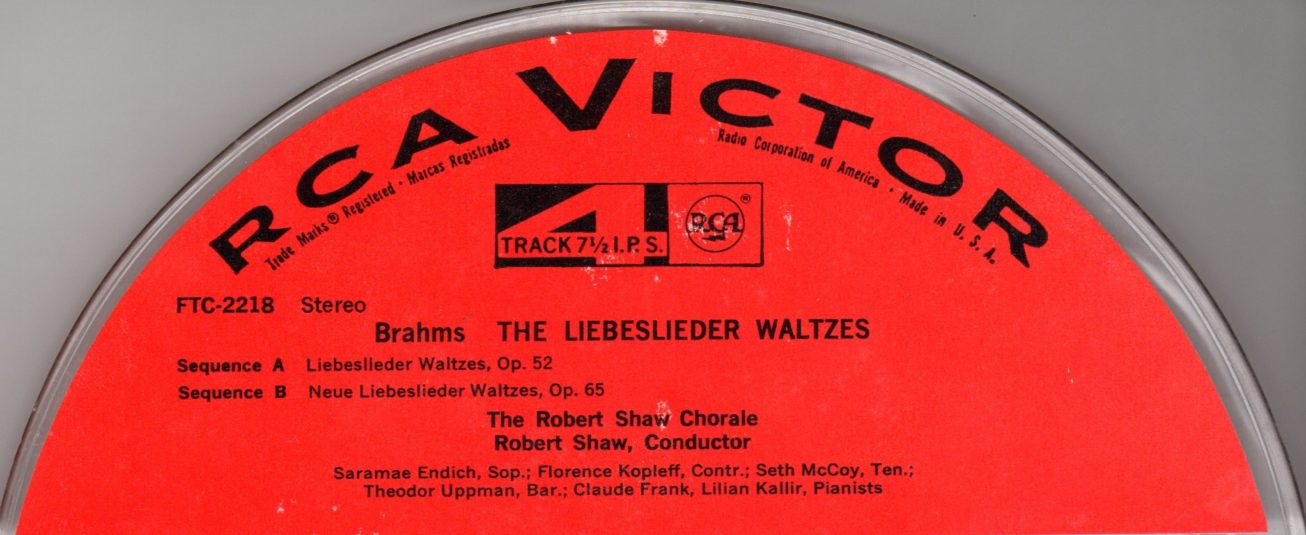
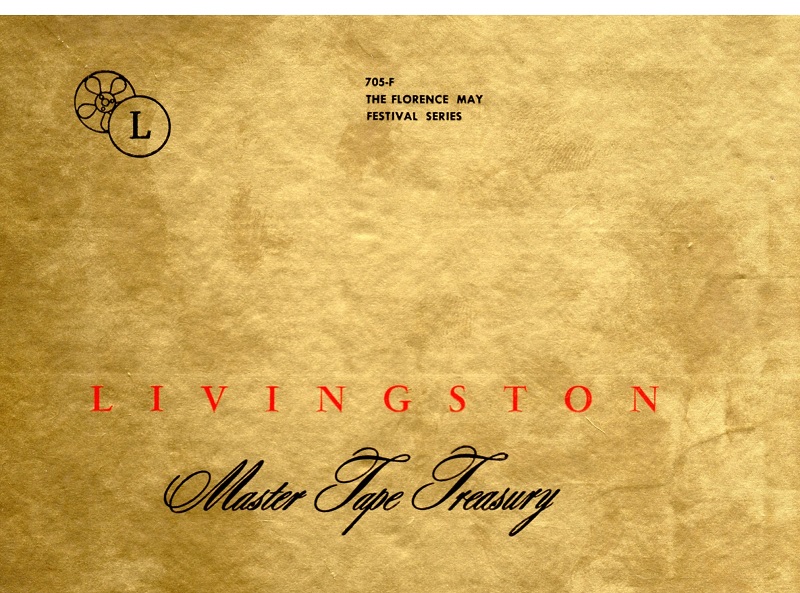
Vittorio Gui – Orchestra del Maggio Musicale Fiorentino
Schubert Symphonie n°8 D759
Rossini Guillaume Tell Ouverture
Brahms Akademische Festouvertüre Op.80
Massenet-Scènes Alsaciennes: n°3 Sous les Tilleuls
Enr/Rec: Teatro Comunale di Firenze – May – June 1953 Stereo
Source: Bande/Tape Audiosphere 701-BN & Livingston 705F
Le Mai Musical Florentin de 1953 (XVI Maggio Musicale Fiorentino) est resté célèbre en raison des représentations de la Medea de Cherubini avec Maria Callas sous la direction de Vittorio Gui.
Fait moins connu, au cours de ce Festival, ont été réalisés les premiers enregistrements stéréophoniques commerciaux en Europe, sous la direction de Vittorio Gui, pour le label américain Livingston fondé par Ched Smiley.
Le directeur artistique de cette production était le chef Hans Wolf (Hamburg 1912- Seattle 2005). Il a étudié notamment avec Heinrich Schenker en 1933 et 1934 et a poursuivi ensuite des études à Vienne. Comme Marcel Prawy dont il était l‘ami, Il s’est engagé dans l’armée américaine en 1943, a obtenu la nationalité américaine et a été envoyé à Vienne au printemps 1945. Avant de s’installer aux Etats-Unis en 1952, il a fait des enregistrements pour le label Remington et un orchestre dénommé «Austrian Symphony Orchestra« (qui était en fait le Niederösterreichisches Tonkünstler Orchester) entre 1950 et février 1952, en tant que chef d’orchestre (Beethoven Symphonie n°5, Brahms Symphonie n°2, Franck Symphonie etc…). Il a également été producteur associé avec Marcel Prawy, pour les enregistrements avec Fritz Busch avec le même orchestre (Haydn Symphonie n°101, Beethoven Symphonies n°3 et 8) pour lesquels l’ingénieur du son était Hans Sachs de la Radio autrichienne RAVAG) et, fait notable avec Vittorio Gui (Mendelssohn: Symphonie n°5 et Ouverture «Les Hébrides», ainsi qu’un disque d’ouvertures).

Hans Wolf – Marcel Prawy – Fritz Busch – Hans Sachs – Wien Oktober 1950
Par ailleurs, le label Livingston était à l’époque engagé dans des recherches de stéréophonie expérimentale, notamment avec le concept de disque à double sillon d’Emery Cook, pour lequel Livingston a commercialisé un bras de lecture « Binaural Arm »:
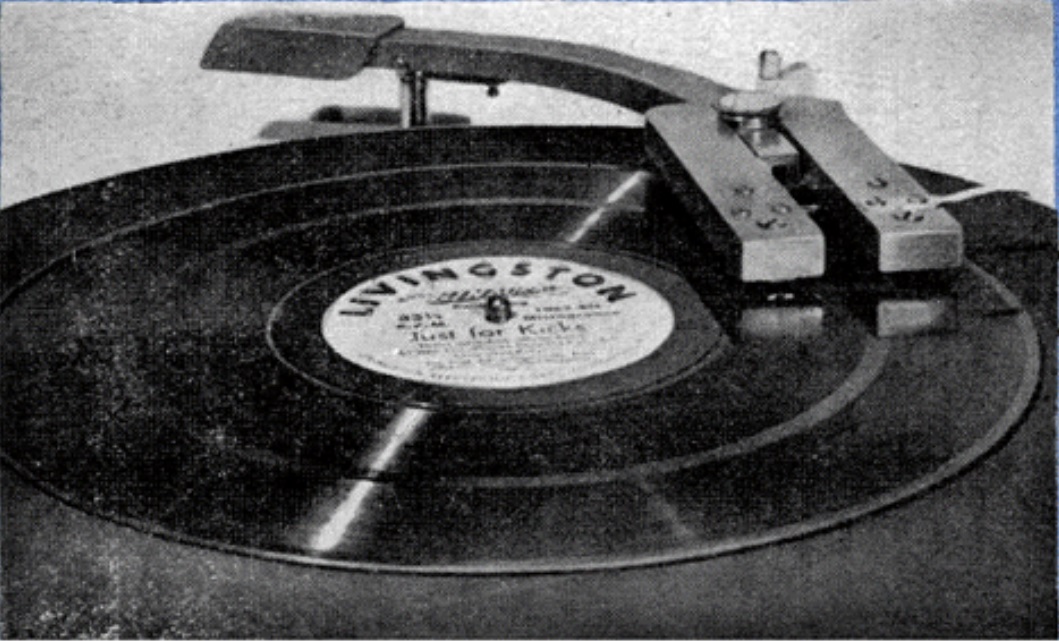
Livingston Binaural Arm
Le nouveau projet de Livingston qui a vu le jour en 1953 était la commercialisation en stéréophonie, sur bandes magnétiques, d’une importante série d’ enregistrements orchestraux faits à Florence sous la direction de Vitorio Gui au cours du Mai Musical Florentin qui a eu lieu entre le 7 mai et le 29 juin 1953. Livingston n’était pas le seul avec un tel projet, mais ses enregistrements orchestraux en stéréo ont précédé ceux d’ AV-Tapes Libraries (Sibelius: Cincinnati SO Thor Johnson enregistré en novembre 1953).
Cinq bandes magnétiques référencées 701 à 705 publiées par Livingston/Audiosphere ont été annoncées dans les numéros de juin et d’août 1954 de la revue Tape Recordings, après avoir fait l’objet au mois de mars d’une présentation au public à Cleveland (Cleveland Chapter 18th Symposium «Stereo Symposium») sous la forme d’émissions radiophoniques FM expérimentales en stéréo.
Lors des séances d’enregistrement à Florence, deux jours ont été consacrés à la mise en place des microphones et à la balance de l’orchestre, le montage des bandes a été réalisé sur place, et les enregistrements ont fait l’objet d’une écoute en vue de leur approbation.
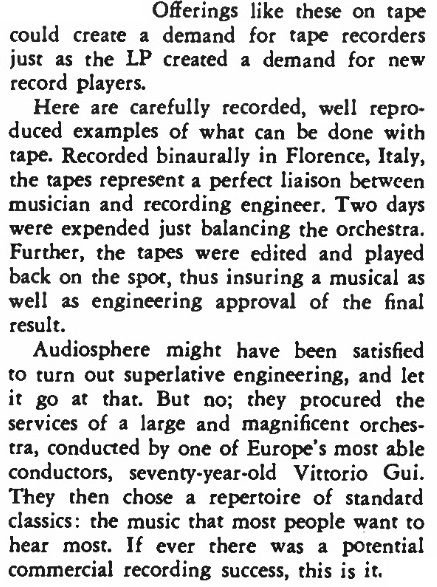
Presentation (Tape Recordings: June 1954)
Dans un article intitulé «Tape makes it easier» paru dans le numéro d’avril 1955 de la Revue «Tape Recordings«, Hans Wolf a dévoilé sa conception personnelle des enregistrements sur bande magnétique et sur le montage, et il a raconté la visite d‘Heinrich Kralik, musicologue et Directeur du département musical de la Radio Autrichienne RAVAG, lors du montage des enregistrements de Vittorio Gui dans une petite salle du Teatro Comunale. Pour le lire, cliquer ICI.
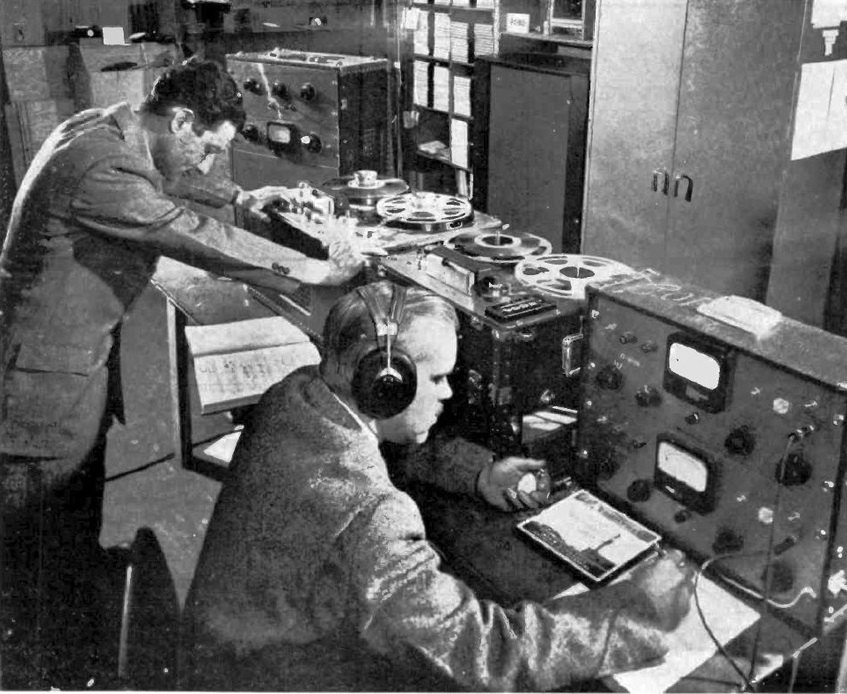
Hans Wolf & Ched Smiley
Les annonces de publications de bandes magnétiques stéréophoniques par de petites firmes (Livingston/Audiosphere et AV Tapes Library) ont créé une forte incitation pour les grands labels et en tout premier lieu RCA qui a annoncé dès juillet 1954 dans la revue High Fidelity sa première publication d’une bande magnétique en stéréo: Strauss Also sprach Zarathustra Chicago SO Fritz Reiner, enregistrement du 6 mars 1954.
Par la suite, les publications pionnières de Livingston sont progressivement tombées dans l’oubli jusqu’à la réédition en 2014 des enregistrements de Vittorio Gui sous le propre label du Festival «Historical Maggio Live» (2CD OF 003).

Bande /Tape Audiosphere BN701

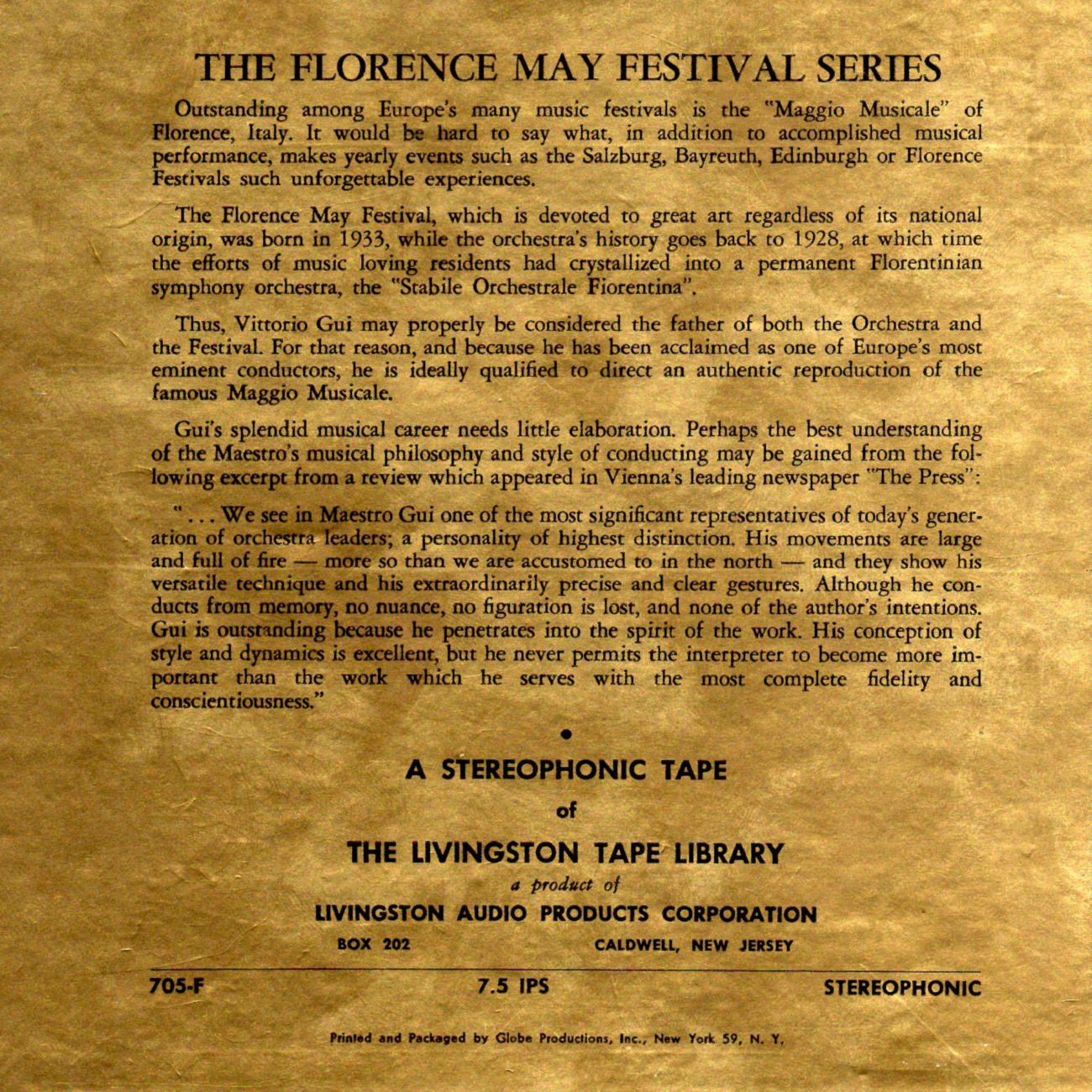
Bande /Tape Livingston 705-F

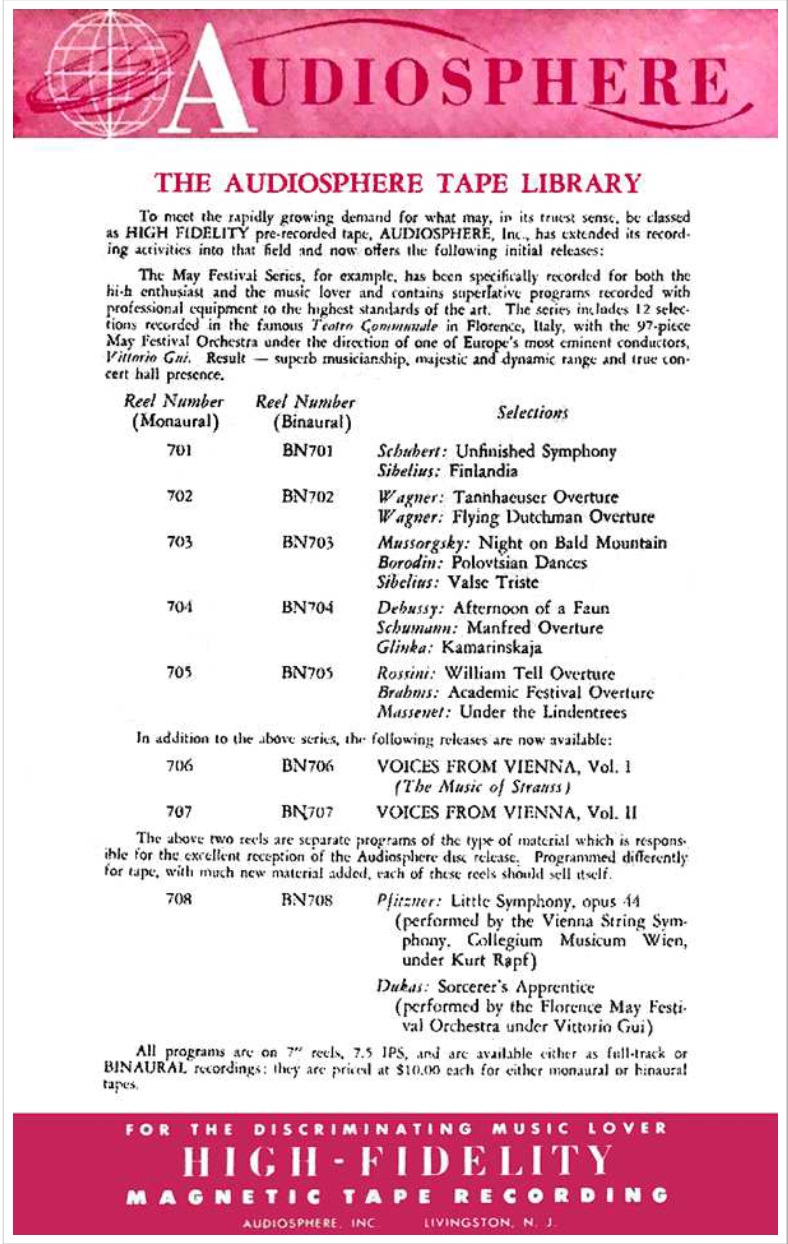
Audiosphere Catalog December 1954
The 1953 Florence May Festival (XVI Maggio Musicale Fiorentino) has remained memorable because of the performances of Cherubini’s Medea with Maria Callas conducted by Vittorio Gui.
But it is much lesser known that during this Festival, the first commercial stereophonic recordings in Europe were made with conductor Vittorio Gui, for the US Livingston label founded by Ched Smiley.
The musical producer was conductor Hans Wolf (Hamburg 1912- Seattle 2005). He studied among others with Heinrich Schenker in 1933 and 1934 and then further studied in Vienna. In the same way as Marcel Prawy who was his friend, he joined the US Army in 1943, became a US citizen and was sent to Vienna in the Spring of 1945. Before settling in the USA in 1952, he made recordings for the Remington label and the so-called «Austrian Symphony Orchestra « (which was in fact the Niederösterreichisches Tonkünstler Orchester) between 1950 and February 1952, as a conductor (Beethoven Symphonie n°5, Brahms Symphonie n°2, Franck Symphonie etc…). He was also the assisting producer to Marcel Prawy, for the recordings with Fritz Busch with the same orchestra (Haydn Symphony n°101, Beethoven Symphonies n°3 and 8) for which the recording engineer was Hans Sachs from the Austrian Radio (RAVAG) and, also worth noting, with Vittorio Gui (Mendelssohn: Symphony n°5 and Overture «Hebriden», as well as a LP comprised of overtures).
On the other hand, the Livingston label was then involved in research in experimental stereophony, especially with Emery Cook’s double groove LP concept, for which Livingston sold a tone arm called « Binaural Arm »:
The new Livingston concept that materialized in 1953 was the commercialization on stereophonic magnetic tapes of an important series of recordings made in Florence under the direction of Vitorio Gui during the May Festival which took place between May 7 and June 29, 1953. Livingston was not the only one with such an idea, but its stereo orchestral recordings were made before those of AV-Tapes Libraries (Sibelius: Cincinnati SO Thor Johnson recorded November 1953).
Five magnetic tapes (Ref: 701 to 705) issued by Livingston/Audiosphere have been announced in the June and August 1954 issues of the review Tape Recordings, just after having been presented to the public in March in Cleveland (Cleveland Chapter 18th Symposium «Stereo Symposium») as experimental stereo FM broadcasts.
Two days of the recording sessions in Florence were used just balancing the orchestra and the tapes were edited and played back on the spot for approval .
In an article titled «Tape makes it easier» published in the April 1955 issue of the review «Tape Recordings«, Hans Wolf unveiled his personal ideas as to recording on magnetic tape and on editing, and he described the unexpected visit of Heinrich Kralik, musicologist and Director of the music department of the Austrian Radio RAVAG, during the editing of Vittorio Gui’s recordings in a small room of the Teatro Comunale. To read it, please click HERE.
The advertised publications of stereophonic magnetic papes by small labels (Livingston/Auduiosphere and AV Tapes Library) generated a strong incentive for the big record companies and in the first place RCA which advertised as early as July 1954 in the review High Fidelity the publication of its first stereo tape: Strauss Also sprach Zarathustra Chicago SO Fritz Reiner, recorded March 6, 1954.
Later on, the Livingston pioneer efforts progressively fell into oblivion until the 2014 re-issue of Vittorio Gui’s recordings by the in-house label «Historical Maggio Live» (2CD OF 003).
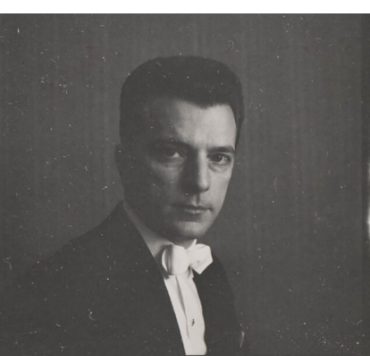
Brahms: Tragische Ouverture Op.81 NBC SO Manhattan Center – January 15, 1951
Brahms: Symphonie n°1 Op.68 NBC SO – Carnegie Hall – December 6, 1952
______
NYPO – Westminster Choir – Carnegie Hall – April 1, 1956
Verdi: Te Deum
Brahms: Alt-Rhapsodie Op.53 NYPO – Martha Lipton
Source: Bande/Tape 19 cm/s / 7.5 ips
Guido Cantelli a peu donné en concert l’Ouverture Tragique de Brahms Op.81, mais par contre sa Première Symphonie Op.68 est l’œuvre qu’il a le plus dirigé. Fin 1950, la NBC a transformé en studio de TV le studio 8-H où avaient lieu la plupart des concerts du NBC SO, et a décidé de les transférer au Manhattan Center, salle à l’acoustique très réverbérée, ce que Toscanini a refusé, seul Carnegie Hall étant pour lui acceptable, et donc seuls d’autres chefs d’orchestre, dont Cantelli, y ont donné temporairement des concerts avec cet orchestre, et la NBC n’a finalement pu que se plier à sa demande.
Le Te Deum de Verdi et la Rhapsodie pour contralto, chœurs d’homme et orchestre Op.53 de Brahms ont été mis au programme des concerts des 29, 30, 31 mars, et 1 avril 1956 du New York Philharmonic et c’est la seule fois qu’il les a dirigées.


Guido Cantelli has seldom performed Brahms’ Tragic Overture Op.81, whereas his first Symphony Op.68 was the work he most conducted. At the end of 1950, the NBC transformed Studio 8-H where most of the NBC SO concerts were given, into a TV studio, and decided to tranfer them to Manhattan Center, a venue with much reverberation, which Toscanini refused, only Carnegie Hall being acceptable to him, and thus only other conductors, among them Cantelli, temporarily gave concerts there with this orchestra and eventually the NBC had to comply with his demand.
Verdi’s Te Deum and Brahms’ Rhapsody for contralto, male chorus and orchestra Op.53 were performed at the New York Philharmonic concerts of March 29, 30, 31 and April 1, 1956 and it it the only time he performed them.
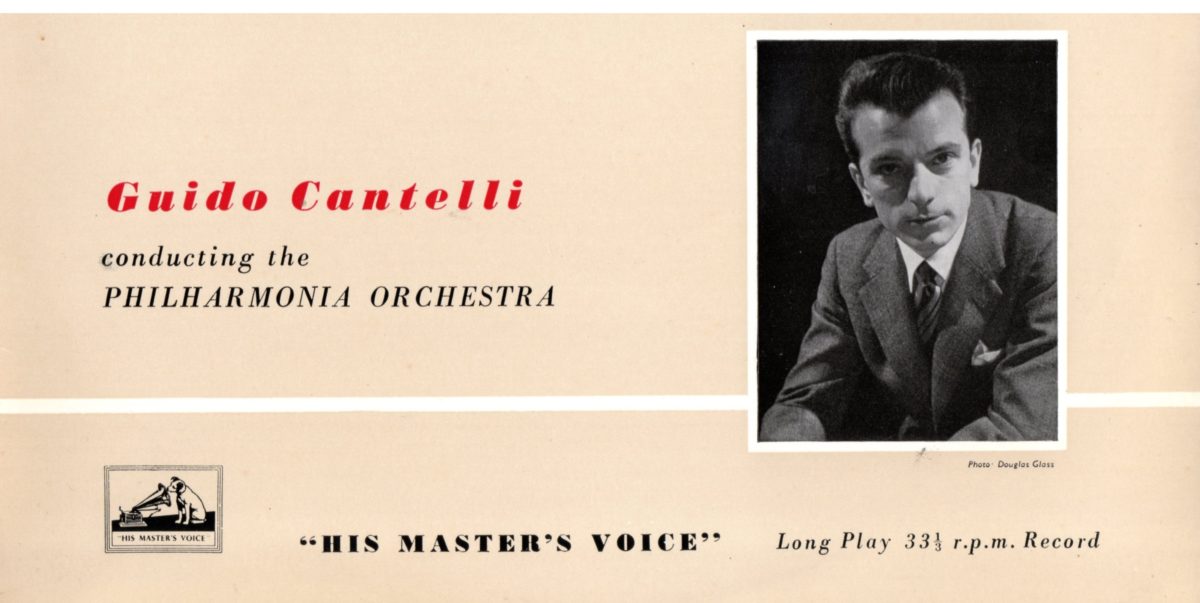
NBC SO Carnegie Hall – 15 December 1951 (Bande/Tape)
_________
Philharmonia Orchestra – 8, 9, 12, 16 &18 August 1955 (GHLP 1004-Mono)
La Troisième Symphonie est réputée comme étant la Symphonie de Brahms la plus difficile à interpréter. Si des chefs comme Walter ou Furtwängler ont signé des versions considérées comme des références, elle a posé beaucoup de problèmes même à de grands brahmsiens, à commencer par Toscanini qui, dans ses témoignages enregistrés, ne l’a vraiment réussie qu’avec le Philharmonia Orchestra, en concert à Londres au Royal Festival Hall en 1952.
C’était par contre une des grandes interprétations de Guido Cantelli qui en a laissé trois témoignages enregistrés (NBC SO, Boston SO, Philharmonia Orchestra).
L’enregistrement réalisé pour HMV/EMI à Kingsway Hall en 1955 a été capté à la fois en monophonie et en stéréophonie expérimentale. A cet effet , il y avait deux équipes de prises de son. L’enregistrement stéréophonique n’a été publié qu’en 1978, et depuis, c’est cette seule version qui est rééditée. Toutefois, en comparant ces deux captations, on constate qu’avec l’étalement en largeur de l’orchestre procuré par la stéréo, la réverbération de Kingsway Hall tend à diluer les timbres et à lisser les phrasés, alors que la prise de son mono, bénéficiant d’un judicieux placement microphonique qui permet à l’acoustique ample de la salle de porter pleinement le son de l’orchestre, est bien mieux définie: l’interprétation sonne de manière nettement plus vivante, et les timbres et les détails du phrasé sont mieux restitués. Avec la version mono, on est aussi musicalement plus proche de la version enregistrée en concert avec le NBC SO.
Le tableau des minutages ci-dessous montre qu’en studio avec le Philharmonia, et comme c’était en général le cas avec Cantelli, les tempi sont plus larges. Il montre aussi qu’en concert, Cantelli faisait la reprise (environ 3′) dans le premier mouvement, mais que cette reprise est malheureusement omise dans l’enregistrement commercial avec le Philharmonia.
Minutages/Timings:
NBC SO 15 Dec. 1951 (12’23; 7’57; 5’35; 8’06)
Boston SO 25 Dec. 1954 (12’28; 7’58; 5’45; 8’02)
NYPO 20 Jan. 1955 (12’40; 7’45; 5’40; 8’10)
Philharmonia Orch Aug. 1955 (9’57; 8’43; 6’18; 8’25)
[Philharmonia Orch Toscanini 1 Oct 1952 (12’27; 8’31; 6’17; 8’34)]
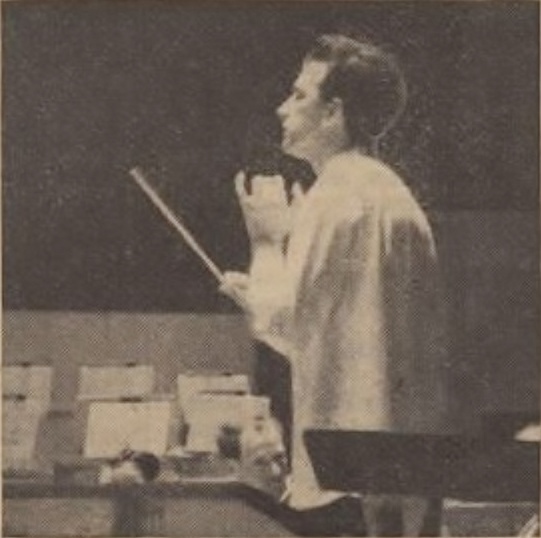
Cantelli Philharmonia Edinburgh
Among the Brahms Symphonies, the Third Symphony is considered as being the most difficult to perform. If conductors like Walter or Furtwängler have made recordings considered as references, it proved problematic even for great Brahms conductors, and for Toscanini to start with, who in his recorded testimonies was only successful with his 1952 London concert in Royal Festival Hall with the Philharmonia Orchestra.
On the other hand, it was one of the great performances of Guido Cantelli who left three recordings (NBC SO, Boston SO, Philharmonia Orchestra).
The 1955 recording for HMV/EMI in Kingsway Hall was made both in mono and in experimental stereo. For this purpose, there where two recording teams. The stereophonic version was published only in 1978, and since then, is the only one to be re-issued. However a comparison between both reveals that, because of the Kingsway Hall reverberation, the spreading in width of the orchestra brought by stereophony goes with a lower definition of the timbres and a smoothing of the phrasings, whereas the mono version, because of a well chosen microphone placement that allows the warm hall acoustics to bring a full-blooded orchestral sound, has much more definition: the performance sounds much more alive, and the timbres and the details of phrasing are better reproduced. With the mono version, we are also musically closer to the concert performance recorded with the NBC SO.
The timings (see above) show that in studio with the Philharmonia, and as was generally the case with Cantelli, the tempi are broader. They also show that, in live performances, Cantelli made the first movement repeat (about 3′), but that this repeat was omitted in the commercial recording with the Philharmonia.
